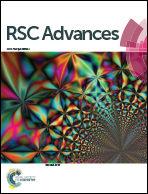Immunochromatographic assay for T-2 toxin based on luminescent quantum dot beads
Abstract
A quantum dot bead based immunochromatographic assay (QB-ICA) system was established for T-2 toxin (T-2), which widely occurs in agriculture and could be used as a potential biological warfare agent. After optimization, the dynamic linear detection range of T-2 calculated from a calibration curve was from 0.12 to 0.67 ng mL−1 and the limit of detection (LOD) was 0.08 ng mL−1, which is lower than those of the ICA based on colloidal gold nanoparticles or a fluorescent material or an antibody-based biochip in other reports. The performance and practicability of the established ICA system were validated with a commercial ELISA kit and the two methods were comparable. The proposed QB-ICA for T-2 could be an alternative for rapid, sensitive, and quantitative on-site detection of this toxin in biosafety monitoring in agriculture and for susceptibility testing of the potential release of this biological warfare agent.



 Please wait while we load your content...
Please wait while we load your content...